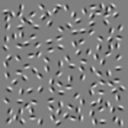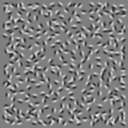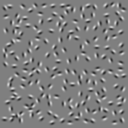
My research is aimed at understanding how visual information is integrated across space, time and its attributes by the human visual system, as well as modeling specific anatomical circuits and interactions between the visual cortical areas involved in these processes. I focus more specifically on orientation selectivity, contour integration, figure-ground segregation, the role of intra- and intereal cortical feedbacks, and their dynamics. To address the nature of these mechanisms, I am interested at combining psychophysical, computational, and brain imaging approaches (fMRI, MEG, TMS & high-density EEG). My long-term goal is to design efficient, reliable and adaptive artificial visual systems for visual rehabilitation.
I'm also founder and chief vision scientist at KyberVision, and software architect for its Psykinematix product dedicated to visual psychophysics, and its vision-related mobile apps for the iOS platform (iPhone, iPod touch and iPad).
Check out my latest blog entry: "Retina Display" in iPad Series.
Biography | Curriculum Vitae | Publications
A selection of publications (Click on title for abstract and PDF full-text, and read the Copyright Notice)
William H.A. BEAUDOT, Ph.D. |
|
Email:
Phone (Japan): +81 70-1141-0245 Fax: (1) 208-575-6276 Last updated: April 22, 2020 |
Beaudot W.H.A., Mullen K.T. (2006) Orientation discrimination in human vision: Psychophysics & Modeling. Vision Research 46(1-2):26-46
Abstract: [Download Full PDF Paper]
 We evaluated orientation discrimination thresholds using an external noise paradigm. Stimuli were spatio-temporal Gaussian patches of 2D orientation noise band-pass filtered in Fourier domain. Orientation acuity was measured for various combinations of stimulus spatial bandwidth, spatial frequency and size as a function of orientation bandwidths of the stimuli. Stimulus contrast was matched in multiples of detection threshold. Consistent with the idea that stimulus orientation bandwidth acts as a source of external noise, orientation discrimination thresholds increased monotonically in all conditions with stimulus bandwidth. To interpret these results quantitatively, we first fitted a variance summation model to the data and derived the internal orientation noise, relative sampling efficiency, and orientation tuning of the mechanism underlying orientation discrimination. Due to the equivocal biological nature of these parameters for orientation discrimination, we investigated, with a modeling approach, how neural detectors characterized by a broad orientation tuning may support orientation discrimination. We demonstrated using the ideal-observer theory that while linear models, based on either unimodal filtering or center-surround opponency, predict the monotonic relationship between orientation discrimination threshold and orientation noise, a nonlinear model incorporating a broadband divisive inhibition in the orientation domain is a better candidate due to its contrast invariance. This model, using broad and similar orientation tuning for its excitatory and inhibitory inputs, accounts for the acute orientation acuity of human vision and proves to be robust despite the variance found in natural stimuli.
We evaluated orientation discrimination thresholds using an external noise paradigm. Stimuli were spatio-temporal Gaussian patches of 2D orientation noise band-pass filtered in Fourier domain. Orientation acuity was measured for various combinations of stimulus spatial bandwidth, spatial frequency and size as a function of orientation bandwidths of the stimuli. Stimulus contrast was matched in multiples of detection threshold. Consistent with the idea that stimulus orientation bandwidth acts as a source of external noise, orientation discrimination thresholds increased monotonically in all conditions with stimulus bandwidth. To interpret these results quantitatively, we first fitted a variance summation model to the data and derived the internal orientation noise, relative sampling efficiency, and orientation tuning of the mechanism underlying orientation discrimination. Due to the equivocal biological nature of these parameters for orientation discrimination, we investigated, with a modeling approach, how neural detectors characterized by a broad orientation tuning may support orientation discrimination. We demonstrated using the ideal-observer theory that while linear models, based on either unimodal filtering or center-surround opponency, predict the monotonic relationship between orientation discrimination threshold and orientation noise, a nonlinear model incorporating a broadband divisive inhibition in the orientation domain is a better candidate due to its contrast invariance. This model, using broad and similar orientation tuning for its excitatory and inhibitory inputs, accounts for the acute orientation acuity of human vision and proves to be robust despite the variance found in natural stimuli.
Beaudot W.H.A., Mullen K.T. (2005) Orientation selectivity in luminance and color vision assessed using 2-d bandpass filtered spatial noise. Vision Research 45(6):687-696
Abstract: [Download Full PDF Paper]
 We
evaluated orientation discrimination thresholds of achromatic, red-green
and blue-yellow chromatic mechanisms using an external noise paradigm. Stimuli
were patches of 2D orientation noise band-pass filtered in the Fourier domain,
and multiplied by a Gaussian envelope in the space-time domain. Stimuli were
cardinal, isolating each of the three post-receptoral mechanisms, and their
contrasts were matched in multiples of detection threshold. Orientation acuity
was measured for a mid spatial frequency (1.5 cpd) as a function of spatial
and orientation bandwidths of the stimuli. We found an overall similar dependence
of orientation discrimination thresholds with external orientation noise
for color and luminance contrast. At narrow stimulus orientation bandwidths,
thresholds are relatively independent of external noise, but as stimulus
bandwidth increases, orientation discrimination thresholds rise. Two different
models were used to fit the monotonic increase of discrimination thresholds
with orientation noise. First we fitted a variance summation model to assess
the internal orientation noise and relative sampling efficiency. Second,
we fitted a gain control model of orientation tuning to derive the orientation
bandwidth and strength of the underlying excitatory and suppressive components
(Beaudot & Mullen, in revision). We find that internal orientation noise
is significantly greater for the chromatic (1.5 0.2 deg) than for the achromatic
(1.0 0.2 deg) mechanisms, while the efficiencies are similar. The nonlinear
model suggests that both chromatic and achromatic mechanisms are characterized by broadly tuned orientation detectors (full-bandwidth at half height of 50 ± 8 deg) and that the relative chromatic deficit in orientation discrimination may only result from a slightly broader orientation tuning for the chromatic mechanisms (+15-20%). We conclude
that color vision (red-green and blue-yellow) has only a moderate deficiency
in orientation discrimination. This may account for the small differences
we have found between color and luminance vision on contour integration and
shape discrimination tasks (Beaudot & Mullen, 2003; Mullen & Beaudot,
2002).
We
evaluated orientation discrimination thresholds of achromatic, red-green
and blue-yellow chromatic mechanisms using an external noise paradigm. Stimuli
were patches of 2D orientation noise band-pass filtered in the Fourier domain,
and multiplied by a Gaussian envelope in the space-time domain. Stimuli were
cardinal, isolating each of the three post-receptoral mechanisms, and their
contrasts were matched in multiples of detection threshold. Orientation acuity
was measured for a mid spatial frequency (1.5 cpd) as a function of spatial
and orientation bandwidths of the stimuli. We found an overall similar dependence
of orientation discrimination thresholds with external orientation noise
for color and luminance contrast. At narrow stimulus orientation bandwidths,
thresholds are relatively independent of external noise, but as stimulus
bandwidth increases, orientation discrimination thresholds rise. Two different
models were used to fit the monotonic increase of discrimination thresholds
with orientation noise. First we fitted a variance summation model to assess
the internal orientation noise and relative sampling efficiency. Second,
we fitted a gain control model of orientation tuning to derive the orientation
bandwidth and strength of the underlying excitatory and suppressive components
(Beaudot & Mullen, in revision). We find that internal orientation noise
is significantly greater for the chromatic (1.5 0.2 deg) than for the achromatic
(1.0 0.2 deg) mechanisms, while the efficiencies are similar. The nonlinear
model suggests that both chromatic and achromatic mechanisms are characterized by broadly tuned orientation detectors (full-bandwidth at half height of 50 ± 8 deg) and that the relative chromatic deficit in orientation discrimination may only result from a slightly broader orientation tuning for the chromatic mechanisms (+15-20%). We conclude
that color vision (red-green and blue-yellow) has only a moderate deficiency
in orientation discrimination. This may account for the small differences
we have found between color and luminance vision on contour integration and
shape discrimination tasks (Beaudot & Mullen, 2003; Mullen & Beaudot,
2002).
Beaudot W.H.A., Mullen K.T. (2003) How long-range is contour integration in human color vision? Visual Neuroscience 20(1):51-64
Abstract: [Download Full PDF Paper]
 We
quantified and compared the effect of element spacing on contour integration
between the achromatic, red-green and blue-yellow mechanisms. The task requires
the linking of orientation across space to detect a contour in a stimulus composed
of randomly oriented Gabor elements (1.5 cpd, sigma = 0.17 deg), measured using
a temporal 2AFC method. A contour of 10 elements was pasted into a 10 x 10
cells array, and background elements were randomly positioned within the available
cells. The effect of element spacing was investigated by varying the mean inter-element
distance between 2 and 6 times the period of the Gabor elements (lambda = 0.66
deg) while the total number of elements was fixed. Contour detection was measured
as a function of its curvature for jagged contours and for closed contours.
At all curvatures we found that performance for chromatic mechanisms declines
more steeply with the increase in element separation than performance does
for the achromatic mechanism. Averaged critical element separations were 4.60.7, 3.60.4, and 2.90.2
deg for Ach, BY and RG mechanisms, respectively. These results suggest that
contour integration by the chromatic mechanisms relies more on short-range
interactions in comparison to the achromatic mechanism. In a further experiment,
we looked at the combined effect of element size and element separation in
contour integration for the achromatic mechanism. We found that the critical
separation decreases linearly with the spatial frequency, from about 5 deg
at low spatial frequency (larger elements) to about 1 deg at high spatial frequency
(smaller elements) suggesting a scale invariance in contour integration. In
both experiments we also found no differences between closed and open jagged
contours detection in terms of element separation. The neuro-anatomical implications
of these findings relatively to area V1 are discussed.
We
quantified and compared the effect of element spacing on contour integration
between the achromatic, red-green and blue-yellow mechanisms. The task requires
the linking of orientation across space to detect a contour in a stimulus composed
of randomly oriented Gabor elements (1.5 cpd, sigma = 0.17 deg), measured using
a temporal 2AFC method. A contour of 10 elements was pasted into a 10 x 10
cells array, and background elements were randomly positioned within the available
cells. The effect of element spacing was investigated by varying the mean inter-element
distance between 2 and 6 times the period of the Gabor elements (lambda = 0.66
deg) while the total number of elements was fixed. Contour detection was measured
as a function of its curvature for jagged contours and for closed contours.
At all curvatures we found that performance for chromatic mechanisms declines
more steeply with the increase in element separation than performance does
for the achromatic mechanism. Averaged critical element separations were 4.60.7, 3.60.4, and 2.90.2
deg for Ach, BY and RG mechanisms, respectively. These results suggest that
contour integration by the chromatic mechanisms relies more on short-range
interactions in comparison to the achromatic mechanism. In a further experiment,
we looked at the combined effect of element size and element separation in
contour integration for the achromatic mechanism. We found that the critical
separation decreases linearly with the spatial frequency, from about 5 deg
at low spatial frequency (larger elements) to about 1 deg at high spatial frequency
(smaller elements) suggesting a scale invariance in contour integration. In
both experiments we also found no differences between closed and open jagged
contours detection in terms of element separation. The neuro-anatomical implications
of these findings relatively to area V1 are discussed.
Beaudot W.H.A., Hess, R.F., Mullen K.T. (2002) Psychophysical evidence of cortical dynamics in contour integration. Perception Vol. 31 Suppl. (Abstract), p. 153
Abstract:
We determined the effect of element separation on the dynamics of contour integration. The task requires the linking of orientation across space to detect a path, measured using a temporal 2AFC method of constant stimuli. Gabor patches (1.5 cpd, sigma=lambda/4) were randomly positioned within a 10x10 square grid with typically 10 elements forming a path. A stimulus cycle consists in a path or no-path stimulus followed by a masking stimulus with random orientation of its individual elements. The path and no-path stimuli were presented cyclically for 1s modulated by a temporal Gaussian window. We measured the effect of the temporal orientation modulation of the individual elements as a function of temporal frequency (1-38 Hz), curvature (0-30 deg) and element separation (2-5xlambda). Our results reveal that the temporal resolution of contour integration: 1) decreases with the element separation; 2) decreases with path curvature at all element separations; and 3) is better for long straight paths (10 elements) than for short straight paths (5 elements) or closed paths, with the largest difference at the shortest element separation. These findings extend our previous results (Hess, Beaudot and Mullen, 2001 Vision Research41 1023 - 1037; Beaudot and Mullen, 2001 Perception30 833 - 853) on the curvature-dependent dynamics of contour integration, and bring new insights of the involvement of feedforward, intracortical and interareal feedback processing in contour integration.
Beaudot W.H.A. (2002) Role of onset asynchrony in contour integration. Vision Research 42(1):1-9
Abstract: [Download Full PDF Paper]
 Evidence
that visual grouping is facilitated when elements comprising a foreground figure
are presented simultaneously, and are temporally separated from elements comprising
the background, has suggested cortical synchronous oscillations as a possible
neural substrate. Supporting this theory, Usher & Donnelly (1998) showed in one of their experiments that contour integration is
facilitated when path and background elements alternate with an asynchrony below the integration time of the visual system, suggesting that these flickering stimuli interact with this hypothetical binding mechanism. I replicated this experiment and report that the effect depends in fact on the
order of asynchrony between path and background elements in the first cycle of stimuli presented for more than 100ms: facilitation in visual grouping only occurs when path elements are presented before background elements. A second experiment, exploring the effect of onset delays between path and background elements, demonstrates a strong priming effect of path elements. I conclude
that Usher & Donnelly's result is likely due to the high sensitivity of the visual
system to stimulus onset, and that simple flickering stimuli are inadequate for
revealing the neural code for binding in figure-ground segregation without controlling
for the effect of stimulus onset.
Evidence
that visual grouping is facilitated when elements comprising a foreground figure
are presented simultaneously, and are temporally separated from elements comprising
the background, has suggested cortical synchronous oscillations as a possible
neural substrate. Supporting this theory, Usher & Donnelly (1998) showed in one of their experiments that contour integration is
facilitated when path and background elements alternate with an asynchrony below the integration time of the visual system, suggesting that these flickering stimuli interact with this hypothetical binding mechanism. I replicated this experiment and report that the effect depends in fact on the
order of asynchrony between path and background elements in the first cycle of stimuli presented for more than 100ms: facilitation in visual grouping only occurs when path elements are presented before background elements. A second experiment, exploring the effect of onset delays between path and background elements, demonstrates a strong priming effect of path elements. I conclude
that Usher & Donnelly's result is likely due to the high sensitivity of the visual
system to stimulus onset, and that simple flickering stimuli are inadequate for
revealing the neural code for binding in figure-ground segregation without controlling
for the effect of stimulus onset.
Beaudot W.H.A., Mullen K.T. (2001) Processing time of contour integration: the role of colour, contrast, and curvature. Perception 30(7):833-853
Abstract: [Download Full PDF Paper]
 We investigated the temporal properties of the red-green, blue-yellow, and luminance mechanisms in a contour-integration task which required the
linking of orientation across space to detect a 'path'. Reaction times were obtained for simple detection of the stimulus regardless of the presence of a
path, and for path detection measured by a yes/no procedure with path and no-path stimuli randomly presented. Additional processing times for contour
integration were calculated as the difference between reaction times for simple stimulus detection and path detection, and were measured as a function of
stimulus contrast for straight and curved paths. We found that processing time shows effects not apparent in choice reaction-time measurements. (i)
Processing time for curved paths is longer than for straight paths. (ii) For straight paths, the achromatic mechanism is faster than the two chromatic
ones, with no difference between the red-green and blue-yellow mechanisms. For curved paths there is no difference in processing time between
mechanisms. (iii) The extra processing time required to detect curved compared to straight paths is longest for the achromatic mechanism, and similar
for the red-green and blue-yellow mechanisms, (iv) Detection of the absence of a path requires at least 50 ms of additional time independently of
chromaticity, contrast, and path curvature. The significance of these differences and similarities between postreceptoral mechanisms is discussed.
We investigated the temporal properties of the red-green, blue-yellow, and luminance mechanisms in a contour-integration task which required the
linking of orientation across space to detect a 'path'. Reaction times were obtained for simple detection of the stimulus regardless of the presence of a
path, and for path detection measured by a yes/no procedure with path and no-path stimuli randomly presented. Additional processing times for contour
integration were calculated as the difference between reaction times for simple stimulus detection and path detection, and were measured as a function of
stimulus contrast for straight and curved paths. We found that processing time shows effects not apparent in choice reaction-time measurements. (i)
Processing time for curved paths is longer than for straight paths. (ii) For straight paths, the achromatic mechanism is faster than the two chromatic
ones, with no difference between the red-green and blue-yellow mechanisms. For curved paths there is no difference in processing time between
mechanisms. (iii) The extra processing time required to detect curved compared to straight paths is longest for the achromatic mechanism, and similar
for the red-green and blue-yellow mechanisms, (iv) Detection of the absence of a path requires at least 50 ms of additional time independently of
chromaticity, contrast, and path curvature. The significance of these differences and similarities between postreceptoral mechanisms is discussed.
Hess R.F., Beaudot W.H.A., Mullen K.T. (2001) Dynamics of contour integration. Vision Research 41(8):1023-1037
Abstract: [Download Full PDF Paper]
 To
determine the dynamics of contour integration the temporal properties of the
individual contour elements were varied as well as those of the contour they
form. A temporal version of a contour integration paradigm (Field, D. J., Hayes,
A., & Hess, R. F. (1993) Vision Research, 33, 173-193)
was used to assess these two temporal dynamics as a function of the contrast
of individual elements and the curvature of the contour. The results show that
the dynamics of contour integration are good when the contrast of the individual
elements is modulated in time (10-30 Hz), but are poor when contour
linking per se is temporally modulated (1-12 Hz). The dynamics of contour linking
is not dependent on the absolute contrast of the linking elements, so long
as they are visible, but does vary with the curvature of the contour. For straight
contours, temporal resolution is around 6-12 Hz but falls to
around 1-2 Hz for curved contours.
To
determine the dynamics of contour integration the temporal properties of the
individual contour elements were varied as well as those of the contour they
form. A temporal version of a contour integration paradigm (Field, D. J., Hayes,
A., & Hess, R. F. (1993) Vision Research, 33, 173-193)
was used to assess these two temporal dynamics as a function of the contrast
of individual elements and the curvature of the contour. The results show that
the dynamics of contour integration are good when the contrast of the individual
elements is modulated in time (10-30 Hz), but are poor when contour
linking per se is temporally modulated (1-12 Hz). The dynamics of contour linking
is not dependent on the absolute contrast of the linking elements, so long
as they are visible, but does vary with the curvature of the contour. For straight
contours, temporal resolution is around 6-12 Hz but falls to
around 1-2 Hz for curved contours.
Beaudot W.H.A., Mullen K.T. (2000) Role of chromaticity, contrast, and local orientation cues in the perception of density. Perception 29(5):581-600
Abstract: [Download Full PDF Paper]
 We
compared the role of the red-green, blue-yellow, and luminance post-receptoral
mechanisms in the perception of density. The task requires the comparison of
densities between two stimuli composed of oriented bandpass elements, pseudo-randomly
scattered across an area of constant size. The perception of density differences
was measured by a temporal 2AFC procedure for all pairs of mechanisms and for
four possible densities. We found that stimuli of identical physical densities
are not perceived equally: there is a consistent bias in favour of blue-yellow
stimuli which are perceived as significantly more dense than red-green and
achromatic stimuli. We considered three factors that could have differentially
affected the density perception of blue-yellow stimuli: an increase in the
perceived size of the individual blue-yellow elements, a perceived contrast
difference, and the presence of local orientation cues. We found that the increased
perceived density of the blue-yellow stimuli occurred despite the fact that
there was no increase in perceived size of the individual elements, and remained
despite corrections for the two other factors. We conclude that the significant
increase in perceived density for the blue-yellow mechanism is a global effect,
associated with a perceived colour 'melting' of the elements in the array.
Our data were fitted with the occupancy model of Allik and Tuulmets (1991,
Perception & Psychophysics
49 303-314) and we found that blue-yellow stimuli have a greater 'occupancy'
than red-green or achromatic stimuli.
We
compared the role of the red-green, blue-yellow, and luminance post-receptoral
mechanisms in the perception of density. The task requires the comparison of
densities between two stimuli composed of oriented bandpass elements, pseudo-randomly
scattered across an area of constant size. The perception of density differences
was measured by a temporal 2AFC procedure for all pairs of mechanisms and for
four possible densities. We found that stimuli of identical physical densities
are not perceived equally: there is a consistent bias in favour of blue-yellow
stimuli which are perceived as significantly more dense than red-green and
achromatic stimuli. We considered three factors that could have differentially
affected the density perception of blue-yellow stimuli: an increase in the
perceived size of the individual blue-yellow elements, a perceived contrast
difference, and the presence of local orientation cues. We found that the increased
perceived density of the blue-yellow stimuli occurred despite the fact that
there was no increase in perceived size of the individual elements, and remained
despite corrections for the two other factors. We conclude that the significant
increase in perceived density for the blue-yellow mechanism is a global effect,
associated with a perceived colour 'melting' of the elements in the array.
Our data were fitted with the occupancy model of Allik and Tuulmets (1991,
Perception & Psychophysics
49 303-314) and we found that blue-yellow stimuli have a greater 'occupancy'
than red-green or achromatic stimuli.
Mullen K.T., Beaudot W.H.A., McIlhagga W.H. (2000) Contour integration in color vision: a common process for the blue-yellow, red-green and luminance mechanisms?. Vision Research 40(6):639-655
Abstract: [Download Full PDF Paper]
 We compare the performance of the red-green, blue-yellow and luminance postreceptoral mechanisms on a contour integration task requiring the linking
of oriented Gabor elements across space to extract a winding 'path' or contour. We first establish that for all three mechanisms curvature and contrast
are independent; losses in performance due to one cannot be compensated by changes in the other. We then compare contour integration by the three
mechanisms using a method that controls for their differences in cone contrast thresholds. Our results show that despite the poor orientation
discrimination thresholds and poor spatial sampling found for the blue-yellow mechanism, all three mechanisms perform similarly on contour
integration over a wide range of curvatures. Furthermore, all three mechanisms have the same dependence on path curvature. We also investigate the
effects of adding external orientation noise. Our results imply that the internal orientation noise for extracting 'aligned' path elements is similar in the three mechanisms and for all path curvatures, and the relative efficiencies are also similar for the three mechanisms. To account for our results, we
propose that the three postreceptoral mechanisms use a common contour integration process. This linking process, however, cannot be color-blind; our
last experiment shows that linking between different chromatic mechanisms or between opposite spatial phases disrupts contour integration. We thus
propose that the common integration process remains sensitive to the color contrast and phase of its inputs.
We compare the performance of the red-green, blue-yellow and luminance postreceptoral mechanisms on a contour integration task requiring the linking
of oriented Gabor elements across space to extract a winding 'path' or contour. We first establish that for all three mechanisms curvature and contrast
are independent; losses in performance due to one cannot be compensated by changes in the other. We then compare contour integration by the three
mechanisms using a method that controls for their differences in cone contrast thresholds. Our results show that despite the poor orientation
discrimination thresholds and poor spatial sampling found for the blue-yellow mechanism, all three mechanisms perform similarly on contour
integration over a wide range of curvatures. Furthermore, all three mechanisms have the same dependence on path curvature. We also investigate the
effects of adding external orientation noise. Our results imply that the internal orientation noise for extracting 'aligned' path elements is similar in the three mechanisms and for all path curvatures, and the relative efficiencies are also similar for the three mechanisms. To account for our results, we
propose that the three postreceptoral mechanisms use a common contour integration process. This linking process, however, cannot be color-blind; our
last experiment shows that linking between different chromatic mechanisms or between opposite spatial phases disrupts contour integration. We thus
propose that the common integration process remains sensitive to the color contrast and phase of its inputs.
Beaudot W.H.A. (1997) A neuromorphic recurrent model for figure - ground segregation of coherent motion. Perception Vol. 26 Suppl. (Abstract), p. 17
Abstract:
A neuromorphic model of the retino-cortical motion processing stream is proposed which incorporates both feedforward and feedback mechanisms. The feedforward stream consists of motion integration from the retina to the MT area. Retinal spatiotemporal filtering provides X-like and Y-like visual inputs with band-pass characteristics to the V1 area (Beaudot, 1996 Perception 25Supplement, 30 - 31).
V1 direction-selective cells respond to local motion resulting from nonlinear
interactions between retinal inputs. MT direction-selective cells respond to
global motion resulting from
spatial convergence and temporal integration of V1 signals. This feedforward
stream provides a fine representation of local motion in V1 and a coarse
representation of global motion in MT. However, it is unable to deal with the
aperture problem.
Solving this problem requires the adjunction of local constraints related to
both smoothness and discontinuity of coherent motion, as well as some minimisation
techniques to obtain the optimal solution. We propose a plausible neural substrate
for this computation by incorporating excitatory
intracortical feedbacks in V1 and their modulation by reciprocal connections
from MT. The underlying enhancement or depression of V1 responses according to
the strength of MT responses reflects changes in the spatiotemporal properties
of the V1 receptive fields. This mechanism induces a dynamic competition between
local and global motion representations in V1. On convergence of these dynamics, responses of V1 direction-selective cells provide a fine representation of `true' motion, thus solving the aperture problem and allowing a figure - ground
segregation based on coherent motion. The model is compatible with recent anatomical,
physiological, and psychophysical evidence [Bullier et al, 1996 Journal de Physiologie (Paris) 90 217 - 220].
Beaudot W.H.A. (1996) Sensory coding in the vertebrate retina: Towards an adaptive control of visual sensitivity. Network: Computation in Neural Systems 7(2):317-323
Abstract: [Download Full PDF Paper]
We propose a theoretical framework for the adaptive control of visual sensitivity in the vertebrate retina. The photoreceptor transfer function is modelled with a Michaelis-Menten law instead of a logarithmic function. This more plausible function has a biophysical correlate, and it allows consideration of the photoreceptor as the main locus of retinal adaptation. The retinal model suggests that the function of photoreceptors might be to control visual sensitivity, defined as the optimal transcoding of non-stationary visual information. This is done by using an adaptive transfer function whose parameters are spatiotemporally and locally estimated by the subsequent retinal circuit and fed back to the photoreceptors. The proposed model also supports the functional architecture of the vertebrate retina.